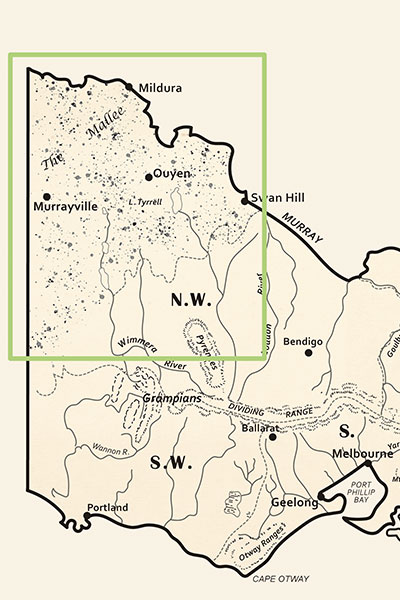The Mallee

Williamson’s major botanical expeditions were spent in the Murray Mallee area, especially around Wentworth, Ouyen, and Mildura to the north west and Murrayville further south. The flora of this region is quite different to that in other parts of Victoria due to the semi-arid climate conditions and low relief (<200 m a.s.l.) in the region.
The vegetation is dominated in large areas by “mallee” eucalypts, including vegetation with an understory of grasses or chenopods, or areas dominated by salt-tolerant vegetation associated with salt lakes.
Between the years 1893 to 1928, Williamson travelled independently to the region by train, then further on by wagonette, river punt, and foot. However, Williamson’s bicycle remained his primary source of transport around the Mallee, and he reported on the challenges of tire punctures caused by Woolly Copperburr (Sclerolaena lanicuspis), which, as the name suggests, has fruit with long spines covered in silky hairs and the Murray Mallee’s red sands turning to mud the ‘consistency of mashed potatoes’ after rain1.

Early European explorers described its landscape as ‘one of the most barren in the world’3 and ‘worthless sand-desert country’3. For many years, the Mallee was overlooked by non-indigenous Australians, who believed that it had nothing to offer. Williamson, however, saw something valuable, asserting that the region was just as deserving of botanical exploration and conservation as other parts of Victoria2.
He expressed his feelings on many occasions in reports for The Field Naturalists’ Club of Victoria and in written articles for newspapers such as the Sunraysia Daily published for the Mildura, Ouyen, and Wentworth communities (left).
It is a wise national policy to foster Australian sentiment, and it behoves all that have influence over their fellow citizens, and especially over the juvenile part of our population, to instil into their minds a love for our native plants and animals, and a desire to see them protected.4
- H.B. Williamson, 1922
There is pleasure in the pathless woods
There is a pleasure in the pathless woods,
There is a rapture on the lonely shore,
There is society, where none intrudes,
By the deep sea, and music in its roar:
I love not man the less, but Nature more,
From these our interviews, in which I steal
From all I may be, or have been before,
To mingle with the Universe, and feel
What I can ne’er express, yet cannot all conceal.
- Lord Byron
________________________________________________________________
Poem enjoyed by Williamson and cited in his “Introductory Article” about the conservation of the Mallee published in The Sunraysia Daily on 30 August 19224.

Flora of the Mallee [Left to right]: Pimelea williamsonii J.M. Black (Williamson’s rice-flower) © Geoff Carle, RBGB, 2021. Coronidium adenophorum (F.Muell.) Paul G.Wilson © Geoff Carle, RBGB, 2021. Eriochlamys behrii Sond. & F.Muell. ex Sond. (Woolly Mantle) © Geoff Lay, RBGB, 2021.
Pimelea williamsonii J.M. Black
Perhaps his most important discovery from the region was Pimelea williamsonii, commonly known as Williamson’s rice-flower, which was found by Williamson in Murrayville in 1916 and named in his honour. He collected specimens on only two occasions before returning in 1922 to find that the land had been cleared to become a sheep run2.
Included in the long list of threatened, endangered, or rare specimens collected by Williamson from the Mallee are Eriochlamys behrii (Woolly mantle, shown right), Eremophila oppositifolia subs. oppositifolia (Twin-leaf emu- bush), Kippistia suaedifolia, Microcybe pauciflora subsp. pauciflora (Yellow microcybe), Minuria integerrima (Smooth minuria) and Pultenaea densifolia (Dense-leaved bush-pea). Many of these species were rarely recorded in Victoria before Williamson’s journeys.


Global impact
Professor A.J. Ewart, Victorian Government botanist and Professor of Botany at the University of Melbourne, stated that Williamson’s contributions from the Mallee were of considerable scientific value and added greatly to our knowledge of native flora1.
Many of Williamson’s specimens collected in the Mallee can be found in Australian and international herbaria, with 944 representatives from the region accessible in the Australian Virtual Herbarium*5. An additional 30 specimens collected by Williamson are housed at the National Museum of Natural History (US) in the United States.
* As of July, 2021. Specimen numbers continue to grow as more are curated and digitised.
References
1. Williamson HB. Botanical notes of a trip to Mildura. The Victorian Naturalist. 1913;30:101–10.
2. Williamson HB. Some plants of the Northern Mallee part II. The Victorian Naturalist. 1930;47:4–8.
3. Australian National Botanic Gardens. Discover Mallee plants - surviving harsh conditions. 2004:16.
4. Williamson HB. The Botany of the Mallee. The Sunraysia Daily [Internet] 1922 Aug 30 [cited 2021 Dec 12].
5. Australasian Virtual Herbarium, [Internet]. Council of Heads of Australasian Herbaria. 2021. H.B. Williamson’s Victorian specimens [cited 2021 Jan 12]. Available from AVH website